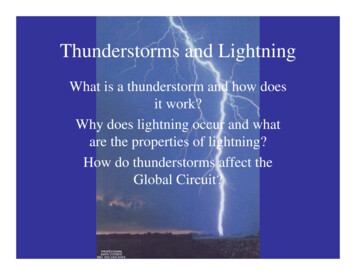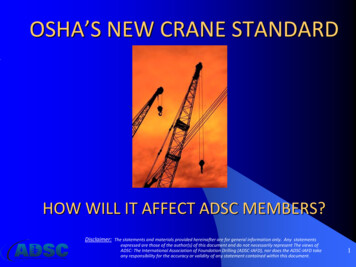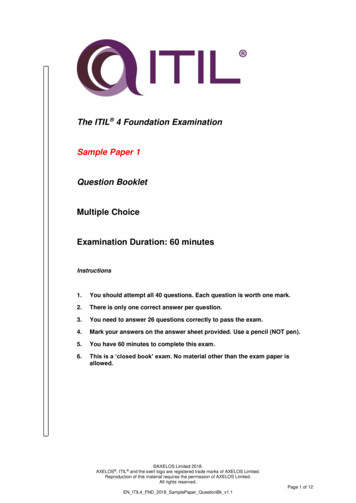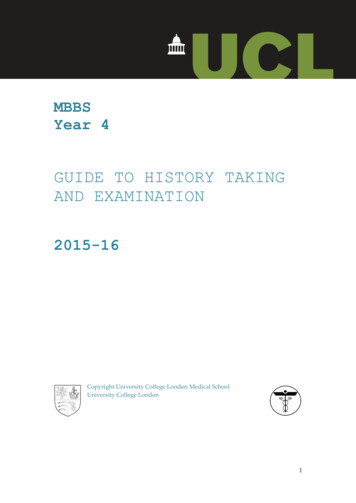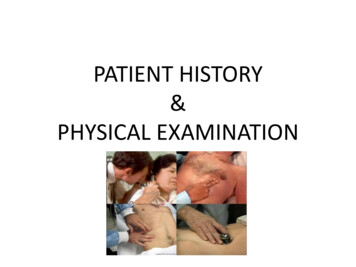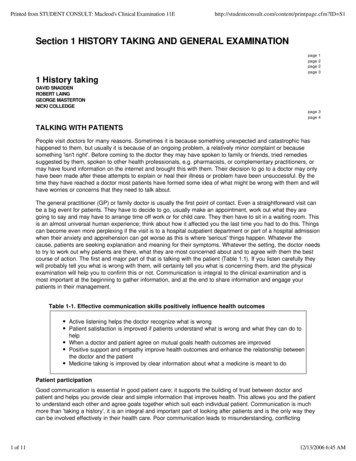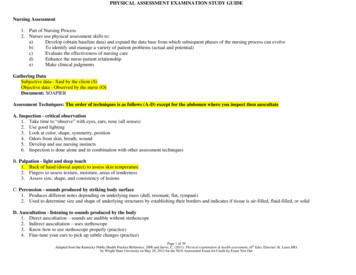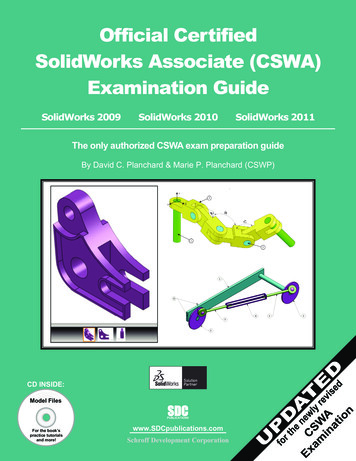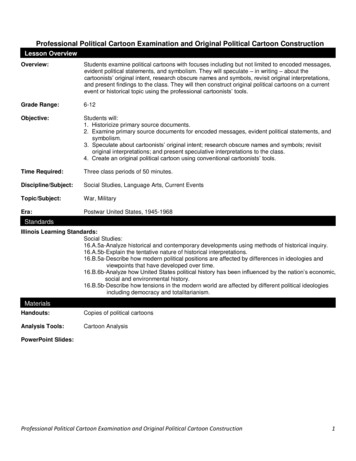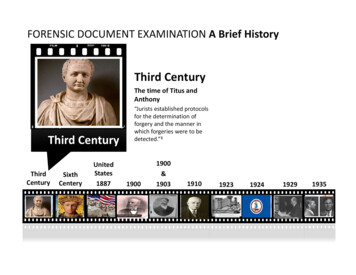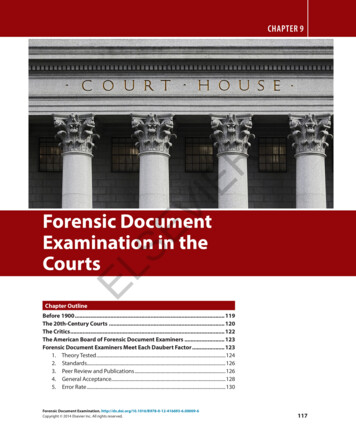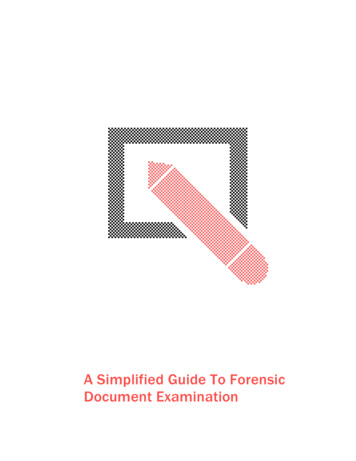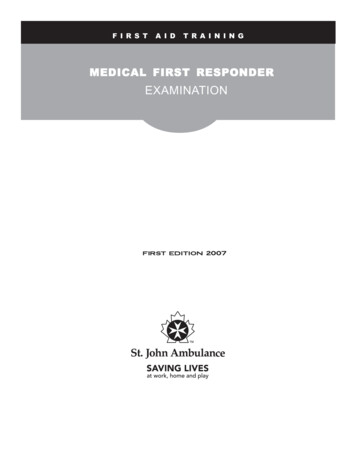
Transcription
F I R S TA I DT R A I N I N GMEDICAL FIRST RESPONDEREXAMINATIONfirst edition 2007
2007 Priory of Canada of the Most Venerable Order of theHospital of St. John of Jerusalem. All rights reserved
General information This exam has two parts: Exam Section 1 – Compulsory Sessions 1 to 13Exam Section 2 – Elective Sessions 14 to 40 Answer only the questions for the elective sessions that your instructor tells you to check offon the answer sheet. The sessions in the exam booklet are identified with the same numbersand titles as on the exam answer sheet. Each question is worth 1 mark. Scoring of exam results To pass, you must obtain a minimum mark of 80% on each section of the exam. – 50 questions. At least 40 questions must be answered correctly. Pass mark: 40/50 Core Section Elective Section– The number of questions may vary depending on the elective lessons.taken. For the combination of elective lessons, the pass mark of 80% shouldbe calculated as follows: [Pass mark of 80%] [Number of questions] X 0.8(round up to the nearest whole number), e.g.: 6 questions x 0.8 pass mark .5/630 questions x 0.7 pass mark . 24/30 When the exam has been corrected, please write the final marks in the spaces provided on thefront of the answer sheet.March 20071
Use the exam answer sheet to fill in the answers. How to answer the exam questions Please do not write in the exam booklet All questions in this exam are multiple choice. Each question has four possible answers. Select the bestanswer. Circle the letters (a, b, c, or d) on the answer sheet next to the question number.Possible answersa.b.c.d. Circle what youbelieve to be the bestanswer. 1. Exam question For example: If you wish to change your answer, place an “X” over your first choice and initial this change. Circle your newchoice.Possible answersXa.b.c.d. Circle your newanswer. Place an X over yourfirst answer and initialthis change. 1. Exam question For example: Good luck! March 20072
Instructions CORE SESSIONS Complete questions 1 through 50 for each of the following multiple choice questions (1 markeach). Circle the letter (a, b, c, d) indicating your answer. If you change your answer before handingin your paper, circle your new choice, place an "X" over your previous choice and initial the change.Last bowel movement.c.Last meal.d.Latest related injury. b.a.Mild airway obstructionb.C.O.P.D.c.Severe airway obstruction.d.Complete airway obstruction.4.The most important step in managingshock is to:a.Keep the patient warm.b.Give CPR as soon as possible.c.Give first aid for the illness or injury.d.Elevate the lower extremities. Location of pain.Increased respiratory difficultyaccompanied by a weak ineffectivecough, wheezing, high-pitchedcrowing noises and cyanosis aresigns of: a.3. The acronym SAMPLE stand for signs andsymptoms, allergies, medications, pasthistory, and events. Which one of the following is not a systemof the body:b.Musculoskeletal.c.Endocrine.d.Follicular. Respiratory. a. 2. 1. Select the single BEST answer to each of the following questions.March 20073
8. A small percentage of casualties withchronic obstructive pulmonary diseasehave hypoxic drive. These patientsbreathe because of a:High oxygen level.b.Low oxygen level.b.Radial.c.Femoral.d.Brachial. Low carbon dioxide level. a. The emergency responder is one link inthe chain of services known as the:Pressing on a fingernail-bed to observe thereturn of normal colour is done to checkfor: a.Normal blood circulation to that part.b.The presence of fractured fingers.c.Pain in the area.d.A lack of oxygen in the blood.Professional Emergency Care (PEC)system. c. Emergency Medical Services (EMS)system. Community Medical Care (CMC)system. The acronym used to assist theemergency responder assessing thepatient's level of responsiveness is:b.EMCA.c.OPQRST.d.AVPU. SAMPLE.10. Your primary survey of a casualty involved ina serious car collision shows only that he isconfused. Later you find his pulse rate at140 and weak, his skin cold and clammy andhis breathing irregular and gasping. Thesesigns, along with the mechanism of injury,indicate:a.An oncoming faint.b.Emotional stress.c.Internal bleeding.d.Onset of diabetic coma. March 2007 a. 7. d. b. Emergency Patient Care (EPC)system.9. 6. d.Carotid. High carbon dioxide level. c.a. a.An industrial worker sustains a severelaceration to his forearm. Direct pressureto the wound fails to control the bleeding.The correct arterial pressure point tocontrol the bleeding is the: 5.4
Herpes.b.AIDS.c.Mononucleosis.d.Hepatitis B.14. During the primary assessment of aresponsive adult patient, you detect abreathing rate of 28 breaths per minute.You would categorize this as:a.Above normal.b.Below normal.c.Normal.d.Indeterminate. 15. A blood-soaked dressing on the armindicates that bleeding has not yet beencontrolled. You should now:b.It can be transmitted by sharing eatingutensils.a.Remove the dressing and check thewound.b.Apply pressure to the femoral artery.c.Place a clean dressing on top andapply more pressure.d.Apply a tourniquet. It can be found in blood and semen.It can be transmitted by shaking hands. d.It can be found in perspiration.hot zoneb.warm zonec.cold zoned.neutral zone . a.16. The type of shock that is caused by asevere infection is called: In a hazmat situation airway managementand immobilzation are carried out in the: 13. c. a. 12. Based on current research, which of thefollowing statements about the AIDS virusis correct? a. 11. For which one of the following infectiousdiseases is a vaccine presently available:March 20075
failure to obtain consent.b.failure to wear your name tag.c.inappropriate use of lights and siren.d.insubordination.a.Pressure points.b.Procedures for administering CPR.c.Manual stabilization of the head.d.Vital signs. 21. You are taking blood pressure by palpation.A radial pulse indicates a blood pressure ofat least:Clonic.b.Aura.c.Tonic.d.Postical.a.110 mmHgb.100 mmHgc.90 mmHgd.80 mmHg 22. You are called for an asthma attack,treatments may include all except:a.Metered dose inhalerb.Bronchodilatorsc.Nitroglycerind.Inhaled steroidsAlert.b.Responsive to pain.c.Not breathing.d.Unresponsive. March 2007 a. 19. The emergency responder shouldassume a head/spinal injury in anyunwitnessed situation where the patientis: a. 18. Immediately before a seizure, the patientexperiences an unpleasant odour. Thisphase is referred to as: a.20. The secondary assessment of the patientconsists of a head to toe examination and acheck of the: 17. Which one of the following is considereda breach of duty:6
b.Away from the midline of the body.c.Nearer the head.d.Away from the head.26. A condition where air builds up in thepleural space, collapses the lung andputs pressure on the heart is called: Nearer the midline of the body.a.Closed pneumothoraxb.Tension pneumothoraxc.Hemothoraxd.Open pneumothorax 27. Oxygen humidification is recommended ifyou are administering oxygen for longerthan:Hypoglycemiab.Congestive heart failure.c.Absence seizures.d.Anaphylactic shock.a.15 minutes.b.30 minutes.c.60 minutes.d.90 nea 28. You find a male patient with obviousdifficulty breathing. He is using his neckmuscles, and is cyanotic. There are redblotches on his chest, and his neck isswelling. You suspect :a.Anaphylaxis.b.Bronchitis.c.Emphysema.d.Asthma. a. Which one of the following breathingdiseases is included in C.O.P.D.: 25. a. 24. Which one of the following conditions maymimic the signs of acute alcoholintoxication? a. 23. In topographic anatomy, the term "lateral"means:March 20077
32. A rapid body survey should take no longerthan:Hold the casualty's mouth closed.b.Pinch the nostrils closed beforeblowing air into the casualty.c.Tilt the head back less than for themouth-to-mouth method of AR.a.30 secondsb.45 secondsc.60 secondsd.90 seconds Keep the mouth and nose closedbetween breaths. 33. To correctly size an oropharyngeal airwayplace the flange at the corner of the mouthwith the tip reaching:5:1b.15:2c.30:2d.35:2a.The angle of the patient's jawb.The top of the patient's earc.The patient's earlobed.Two fingerswidth from the flange. 34.ASA should be offered to the patient withchest pain who is taking nitroglycerin:65 plus the man's age up to 120 mm.Hg.Before the first dose of nitrob.After the first dose of nitroc.After the second dose of nitrod.After the third dose of nitro b.a. 50 plus the man's age up to 150 mm.Hg.100 plus the man's age up to 150mm. Hg. d. 80 plus the man's age up to 130 mm.Hg. March 2007 c. a. 31. A guideline for normal systolic bloodpressure in an adult male would be: a. 30. During one-rescuer CPR for adults, theratio of compressions to ventilationsshould be: d. a. 29. When you are giving mouth-to-nose AR,you should:8
Insert the suction tip deep into thelarynx.c.Suction for no more than 15 seconds.d.Insert the tip with the curved sidetowards the tongue.Three ribs are broken on each side ofthe chest.b.Part of the spine becomes separatedfrom the ribs.c.The breastbone is broken in threeplaces.d.Several ribs are broken in more thanone place. b.a. Apply suction as soon as the suction tiptouches the mouth.b.Plastic face mask.c.Partial rebreathing mask.d.Non-rebreathing mask. a.Normal seizure pattern in epilepsy.b.Seizures caused by a high fever.c.Continuous seizure activity.d.Seizures lasting longer than 2minutes. Nasal cannula. 40. OPQRST is used to assess:a.Painb.Level of consciousnessc.Visiond.Hearingb.Radiates to the neck, jaw and arms.c.Is not relieved by rest or medication.d.Lasts for about 3 minutes. Is under the sternum. a. 37. You suspect a patient's pain is due to amyocardial infarction rather than anginabecause the pain: a.39. Status epilepticus refers to: 36. Which of the following devices provides thehighest percentage of O2 delivery? a.38. A flail chest results when : 35. When suctioning a non-breathing adultcasualty, a first aider should:March 20079
1-6 litres/min.b.6-8 litres/min.c.8-12 litres/min. d.10-15 litres/min.44. To prepare a completely amputated partof the body for transportation to hospitalwith the casualty, you should:a.Place it in a clean plastic bag filledwith cold water.b.Wrap it in clean, moist dressings andkeep it cool.c.Wash it off and place it into a bag ofcrushed ice.d.Wrap it in clean, moist dressings andkeep it at body temperature.b.Crepitus, pain, resistance.c.Pain, circulation, retention. 45. Hypovolemic shock results from: Pulse, movement, sensation.a.The body's reaction to a foreignprotein.b.An overdose of insulin.c.Toxins produced by a severeinfection.d.Decreased volume of the blood.Tingling, numbness, paralysis. Once the breathing has beenchecked.a.Turn him into the recovery position withhis unaffected side down.b.Place him in a semisitting position.c.Turn him into the recovery position withhis unaffected side up.d.Place him on his back.When a hard collar has been applied.c.If the patient is unconscious.d.When the patient is fully immobilizedto a backboard. March 2007 b. a.46. A conscious casualty who has suffered astroke becomes unconscious. To keep hisairway open and help him breathe, youshould: 43. Manual support of the head and neck ofthe patient with suspected spinal injurycan be released: d. a. 42. When aligning the head in the eyes-frontneutral position, watch for: a. 41. The recommended oxygen flow rate fornasal cannulae (nasal prongs) is:10
49. The correct ratio of compressions toventilations for two -rescuer CPR on achild is:b.Perform a secondary survey.c.Take charge and perform a scenesurvey.d.Asess the rate and quality of breathing. Take a SAMPLE history.a.5:1b.15:2c.5:2d.15:1a.Inadequate circulation to the body’stissuesb.Inadequate delivery of oxygen to thelungsc.Inadequate elimination of wasteproducts from the body.d.Inadequate amount of insulin. 50. Shock is best defined as:The circumstances after the injury.c.The weather conditions at the time ofthe incident. b. The force that causes the injury and theway it acts on the body. The area of the body that is injured d. a. 48. To determine whether a c-spine injury hasoccurred, you should think about theMechanism of Injury. This can best bedescribed as: a. 47. A worker has fallen from a six-foot ladderonto a concrete floor. You first actionshould be.March 200711
ELECTIVE SESSIONS Instructions Complete only the multiple choice questions that correspond to the electives of your program. (1mark each). Circle the letter (a, b, c, d) indicating your answer. If you change your answer beforehanding in your paper, circle your new choice, place an "X" over your previous choice and initial thechange. AED54. When transporting a patient, a shock should beadministered:The skill of the AED responder.c.The patient’s previous cardiachistory. b.a.Only in a vehicle that is properlygrounded.b.Whenever the machine indicates shocknecessary.c.When the vehicle is stopped.d.When the vehicle is travelling at less than20 km per hour. The time from collapse todefibrillation. The type of defibrillator used.With a sinus rhythm.b.In asystole.c.In ventricular fibrillation.d.With pulseless electrical activity (PEA).55. When using an AED on a patient who is wearinga pacemaker, place the electrode pads:a.Directly on pacemaker.b.Two inches away from pacemaker.c.Within one inch of the pacemaker.d.At least one inch away from pacemaker.b.2.c.3.d.4. 1. March 2007 a. 53. In the hypothermic patient you should limit thenumber of shocks to a maximum of: a. 52. The AED will shock a patient: d. a. 51. The most critical factor in defibrillation is: 14 14 Select the single BEST answer to each of the following questions.12
59. The most immediate seriouscomplication associated with burns is:b.Leave the AED attached to the casualty.c.Disconnect the cables from the AED.d.Remove the pads from the chest.a.Shockb.Infectionc.Scarringd.Hypothermia Remove the AED from the scene. BurnsSuperficial.b.Partial thickness.c.Full thickness.d.First degree. 60. A man is filling a gas tank on a generatorwhen it bursts into flames. The caualty hasa hoarse voice, he is blistered around themouth and nose and both arms arereddened. You should classify this burn as:a.Criticalb.Superficialc.Moderated.Minor16Wound Managementa.A deep break in the skin involvingsignificant bleeding.b.Partial or complete loss of a body part.c.The result of a sharp object driventhrough soft tissue.d.A scrape or rubbing away of theepidermis. 61. An abrasion is:Oneb.Twoc.Fived.Nine a. 58. In determining the amount of bodysurface burned, the area of the palm ofthe hand represents % of the bodysurface. a. 57. Burns that involve all layers of the skinare: 1515 a. 56. You have shocked a casualty and there aresigns of circulation. You should:March 200713
A laceration.b.An avulsion.c.A contusion.d.A concussion.a.That involves specific infection in thelower jaw.b.That only occurs in the third world.c.That is caused by a virusd.That can be prevented byimmunization.Signs and symptoms used to determinethe need to transport. b.66. Which one of the following factorsincreases the risk of life -threateninginjury: The assessment of the severity of awound injury.a.High velocity.b.Low velocity.c.High density.d.Low energy.Signs of infection as assessed in woundinjuries. d. The depth of a penetrating wound andpotential damage. 67. Which action is part of first aid for anosebleed?All open wounds are contaminated tosome degree.c.The risk of infection continues until thewound is dressed and bandaged.d.Gloves should be worn if you suspectthe patient may be ill.Place an ice-pack on the back of theneck.b.Plug the nose with gauze.c.Lean forward and firmly pinch the softparts of the nose.d.Lean the casualty backwards in asitting postion. b.a. Wounds should be thoroughly flushed toprevent infection. March 2007 a. 64. Responders involved in wound managementshould consider: c. a. 63. The acronym SHARP refers to: a.65. Tetanus is a condition: 62. A soft tissue injury resulting from theimpact of a blunt object is called:14
70. If it becomes necessary to thaw a handwith deep frostbite you should ensurethat:Wiping lightly over the edges of thewound.c.Swabbing from one side of the wound tothe other.d.Wiping away from the edges of thewound. b.a.The patient sees a doctor no laterthan 48 hrs after thawingb.There is no danger of refreezingc.Adequate pain relief medication isavailabled.Capillary refill takes no longer than15 seconds Swabbing in circular motions around thewound.71. You have been called for an 81 year oldunconscious male patient. He is in his livingroom. Despite the hot day, he is overlydressed. He is flushed and dry, extremelyhot to touch. You suspect:17a.Heat adiation, refrigeration, evaporationand conduction.c.conduction, convection, evaporationand refrigeration. b. radiation, conduction, evaporationand respiration.1418Lifting and Carrying72. Body mechanics refers to:a.Positioning and movement of the bodyb.Number of rescuers needed to move apatientc.A type of rescue carryd.A special device to lift heavy loads submersion, convection, radiationand respiration. d. a. 69. The body loses heat in a variety of waysincluding: Heat and Cold Illness and Injury a. 68. To prevent further contamination andinfection of a wound, you should cleanse thesurrounding skin by:March 200715
76. After discovering a possible fracture youshould assess which of the following beforeand after splinting:b.Keep his body rigid, support his head andneck and roll him away from the scene.c.Tie his legs together and drag him feetfirst. Grab his wrists and drag him lengthwise.a.Sensation, morbidity, protrusion.b.Capillary refill, pulse, sensation.c.Pulse, motor function, sensation.d.Crepitus, resistance, pain. Grasp his clothing under his shoulders,support his head and neck, and drag himlengthwise.2 rescuersb.3 rescuersc.4 rescuersd.5 rescuers77.A worker has had his hand caught in a cardoor. You suspect several fractured bonesin the hand. The hand should be splinted:a.Flat against the splint.b.In a tight fist position.c.With the fingers taped together.d.In the position of function.19A type of splintd.A type of fracture An arm sling supported with broadbandages.b.A St. John tubular sling tied on theinjured side.c.A St. John tubular sling tied on theuninjured side.d.Rigid splints to support the arm andsupport the shoulder. c.a. A grating sound caused by bone endsrubbing together March 2007 b. a. Poor distal circulation78. In the case of suspected fracture of theclavicle, emergency responders should use: 75. Crepitus is: Musculoskeletal - Upper Limbs a. 74. To safely perform a chair carry you need d. a. 73. You are alone and must remove a casualtywith a suspected spinal injury from a veryhazardous situation. You should16
82. Effective immobilization of the tibia includesimmobilization of the:a.Knee, tibia, fibula and ankle.b.Femur, knee, tibia and ankle.c.Femur and ankle.d.Hip, femur, knee, tibia and ankle.Sprainb.Fracturec.Dislocationd.Strain 83. You can best control the swelling and painof an ankle sprain by:In the injured limb only.b.Distal to the injury.c.Proximal to the injury.d.At the site of the fracture.a.Tight bandages and a heating pad.b.Rest, immbolization, application of cold,and elevation.c.Rigid splints and bandagesd.Compression, elevation and applicationof heat. Musculoskeletal - Lower LimbsHumerus.b.Fibula.c.Tibia.d.Femur. a. 81. The longest, strongest bone in the body isthe: 20 a. 80. After an extremity fracture has beenimmobilized, the responder should check forcirculation: a. 79. Force on a joint may cause bone ends tocome out of their proper position. This typeof injury is called a:March 200717
Head/spinal/pelvic Injury Attempt to push bones back into thewound.a.Bruising or swelling of the spinal cord.b.Tearing of brain tissue.c.Pooling of blood in the brain.d.Temporary loss of brain functionApply pressure directly over thefracture to control bleeding.d.Apply a tourniquet above the fracturesite. c. Use bulky dressings to pad around theprotruding bones ends. b. a.86. A concussion is best described as: 84. If the patient has an open fractureresponders should : 2121 a. Soft spots in the infant’s skull.A fractured pelvis.b.An injured knee joint.c.A dislocated hip.d.A mid-shaft femur fracture.b.Infant’s pupils react differently thanadults.c. Whether or not the infant can cryforcefully.d.The startle reflex.88. When immobilizing a patient on a spineboard, which part of the body is the firstto be strapped?a. Chestb. Pelvisc. Legs March 2007 a. 85. A traction splint could be used for which of thefollowing injuries: 87. You are examining the head of an infant whohas been involved in a car crash. You needto be aware of:18d. Head
91. Which one of the following changes in vitalsigns is characteristic of brain injury: Usually controlled with directpressurea.Increase in pulse rate.b.Constant respiratory rate.c.increase in blood pressure.d.Decrease in blood pressure.Usually associated with scalplacerations c. Very serious for the patient due toincreased pressure in the brain.Almost always seen in children.b.Pulse rate, speech, involuntarymovement. a.Possible eye injuryb.Possible fracture of the jawc.Possible scalp lacerationd.Possible head injury Eye, verbal and motor responses.Respiration rate, eye response,voluntary movement. d. Pulse rate, respiration rate, eyeresponse. c. a.92. “Raccoon eyes” indicates: 90. The Glasgow Coma Scale measures threebasic functions. They are: d. b. a. 89. Contusions are:March 200719
a.Ruptured bladder.b.Ruptured spleen.c.Spinal injuries.d.Rib fractures. Suspect spinal injury and manageaccordingly.Advise the person to lie down in case offainting.d.Determine the chief complaint andprovide first aid for it. c. Not worry about spinal injury becausethe person is mobile.97.To properly measure a cervical collar, you:a.Measure the distance from the ear lobeto the shoulder.b.Measure the distance from the cornerof the mouth to the ear lobe.c.Measure the distance from thecheekbone to the shoulder blade.d.Measure the distance from thetrapezius muscle to the angle of the jaw The cervical immobilization device isapplied by the police. Transport the patient in the position ofgreatest comfort.Apply a cervical immobilization devicebefore assessing the patient. d.Responders must provide initialstabilization by supporting the head andensuring neutral alignment22Poisons, Bites and Stings 98.Contact dermatitis occurs when:If the patient will be immobilized to along spinal immobilizaton device.c.When the helmet has a face mask thatinterferes with the responder’s abilityto assist with ventilations b.a.The skin comes in contact with apoisonous substance.b.A poison enters the eye of a contactlens wearer.c.Hot gases are inhaled.d.A poison is injected under the skin. If there are no airway or breathingproblems. It is a full- face helmet. March 2007 d. a. 95. A helmet must be removed from a patient: c. b. a. 94. When managing a possible spinal injury: b. a.When dealing with pelvic injuries you mustalways consider the possibility of: 96. 93. You are called to the scene of a motorcyclecrash. The rider is dazed and walkingaround. You should:20
Carbon monoxide:102. Muscles are attached to the bones by: May result from fires or ge.d.Tendons.c.Is not life-threatening.d.Requires the administration of lowconcentration O 2. Has a very distinct odour 103. The appendix is located in which quadrant ofthe abdomen:Call your local Poison Control Centreand follow directions. b.a.Lower right.b.Upper right.c.Upper left.d.Lower left. Dilute the poison with severalglasses of cool water.Use activated charcoal. d. Give a solution of mild liquid dishdetergent and water. c. a. 100. A child has swallowed an unknownpoisonous substance. You should: b. a. 99.Cutaneous tissue.b.Dermis.c.Adipose tissue.d.Epidermis. a. 101. The external layer of the skin is called:: Anatomy and Physiology 23 14March 200721
106. The pulse point located in the upperportion of the thigh is called the:b.Sclera.c.Cornea.d.Iris. Pupil.a.Popliteal.b.Femoral.c.Brachial.d.Temporal. 107. Which one of the following is a functionof the skin?Cervical vertebrae.b.Thoracic vertebrae.c.Lumbar vertebrae.d.Coccygeal vertebrae.a.Regulation of oxygen levels.b.Production of proteins.c.Regulation of body temperature.d.Removal of carbon dioxide. March 2007 a. 105. A skeletal injury to the lower back could resultfrom direct trauma to the: a. 104. The white exterior portion of the eye is calledthe:22
Behavioural Emergencies 110. When communicating with tay at eye level & maintain eye contact.b.Stay as close to the patient as possible.c.Use medical terminology to enhancecredibility.d.Hide facts if the situation is serious.111. In cases of behavioural disorders, theresponder should:a.Always use restraints.b.Give the patient a choice in the treatmentc.Play along with auditory or visualhallucinations.d.Force the patient to make decisions.Spleen.Liver.c.Pancreas.d.Gall bladder.112. The best way to prevent a Critical IncidentStress situation from becoming worse is:a.Ignore it.b.Be familiar with the signs and symptoms.c.Ensure early use of proper medication.d.Force the responder to talk about thesituation. b. a. 109. Insulin is produced in the: a. 108. Urine is expelled from the body throughthe: 24March 200723
There is a chemical burn to the eye.The eyeball is injured.Transport time is short.The casualty is wearing hard lenses.c.Lacerations to the globe.d.Discolouration of the orbits.116. Eye injuries that include lacerations: a.Should be covered with clean, moistdressings.b.Iindicate possible skull fracture.c.Usually involve a great deal ofbleeding.d.Require moderate pressure on theeye to control bleeding. Remove the particle with a moist cornerof a facial tissue or clean cloth.Flush the eye with water for 10 minutes. c.Use a splinter forcep to remove theparticle. Cover the eye and transport the casualtyto medical help.117. Irrigate eyes with:a.Diluted vinegar.b.Saline solution.c.An appropriate chemical antidote.d.Sodium bicarbonate. March 2007 d. b. a. 114. You discover a particle embedded in thecasualty’s cornea. You should: d.Gritty feeling in the eyes. c.b. b.Bleeding from the conjunctiva. a.a. 113. Remove a contact lense only if:115. Signs and symptoms of intense light burnsto the eyes include: Eye Injuries25 2524
26Gastrointestinal and Genitourinary a.Irrigate the wound before dressing it.b.Give oxygen by nasal canula.c.Dress the wound with a moist, steriledressingd.Gently reposition the organs in theabdominal cavity.Excessive hunger or thirst.b.Hypertension and brachycardia.c.Distension with rebound tenderness.d.Fever with deep, shallow breathing.122. "Referred pain":Pain and tenderness at site.b.Pale, ashen skin colour at site.c.Hernia can be pushed back into body.d.Hernia is above the diaphragm.a.Occurs when the sensation of pain isdelayed.b.Results when the two nervous systemscome into contact.c.Is the symptomatic description of pain by thepatient.d.Is the description of pain as recorded on thepatient care report.b.Give oxygen by non-rebreather mask.c.Be prepared to deal with vomiting.d.Monitor the patient for signs ofhypovolemic shock. 123. Trauma to male and female genitalia:a.Often involves significant bleeding.b.Is not usually painful because of protectednerve endings.c.Usually results in sterility.d.Often results in post-traumatic infection. Establish the cause of the pain. a. 120. Which one of the following is not crucial incases of abdominal distress: a. 119. Signs that a hernia is serious include: a. 118. Signs and symptoms of acute abdomeninclude:121. In the case of abdominal evisceration, theemergency responder should: 26March 200725
Overestimating the resources that maybe required.a.Incident manager.b.Triage officer.c.Staging officer.d.Communications officer.Comprehensive care of all patients.c.Planning for the positioning of allvehicles.d.Arranging for advanced level careproviders at the scene. b. a.127. The most knowle
a. Before the first dose of nitro b. After the first dose of nitro c. After the second dose of nitro d. After the third dose of nitro 30. During one-rescuer CPR for adults, the ratio of compressions to ventilations should be: a. 5:1 b. 15:2 c. 30:2 d. 35:2 33. To correctly size an oropharynge
